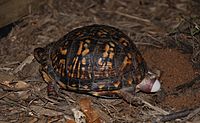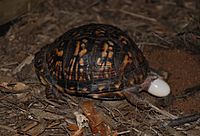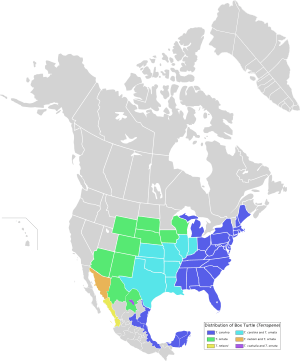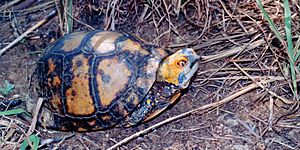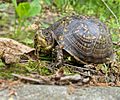Box turtle facts for kids
Quick facts for kids Box turtle |
|
|---|---|
 |
|
| A Florida box turtle, Terrapene carolina bauri | |
| Scientific classification |
|
| Kingdom: | Animalia |
| Phylum: | Chordata |
| Class: | Reptilia |
| Order: | Testudines |
| Suborder: | Cryptodira |
| Family: | Emydidae |
| Subfamily: | Emydinae |
| Genus: | Terrapene Merrem, 1820 |
| Type species | |
| Terrapene carolina (Linnaeus, 1758)
|
|
| Species | |
|
Terrapene carolina |
|
| Synonyms | |
|
Cistuda Fleming, 1822 |
|
Box turtles are special turtles found in North America. Even though they look a bit like tortoises and live on land, they are actually part of the American pond turtle family, called Emydidae.
There are six main types, or species, of box turtles. They are easy to spot because of their high, rounded shell. This shell has a special hinge at the bottom. This hinge lets the turtle pull its head and legs inside and close its shell very tightly. It's like a strong, natural shield that protects them from animals that might try to eat them!
Contents
Types of Box Turtles
The name Terrapene was first used in 1820. It described turtles with a shell that could move in parts. Today, there are six main species of box turtles. Some of these species also have different subspecies, which are like different groups within the same species.
Here are the main species of box turtles:
- Common box turtle, Terrapene carolina
- Florida box turtle, Terrapene carolina bauri
- Eastern box turtle, Terrapene carolina carolina
- Gulf Coast box turtle, Terrapene carolina major
- Three-toed box turtle, Terrapene carolina triunguis
- Coahuilan box turtle, Terrapene coahuila
- Mexican box turtle, Terrapene mexicana
- Spotted box turtle, Terrapene nelsoni
- Northern spotted box turtle, Terrapene nelsoni klauberi
- Southern spotted box turtle, Terrapene nelsoni nelsoni
- Western box turtle, Terrapene ornata
- Ornate box turtle, Terrapene ornata ornata
- Desert box turtle, Terrapene ornata luteola
- Yucatán box turtle, Terrapene yucatana
Box Turtle Life and Habits
How Long Do Box Turtles Live?
Once a box turtle becomes an adult, its chance of dying doesn't really go up with age. Adult box turtles usually live for about 50 years. Many can even live for over 100 years!
It's hard to guess a wild box turtle's age by counting the rings on its shell. Things like how much food they eat, what kind of food, water, and if they get sick, all affect how they grow.
Box Turtle Eggs and Babies
Box turtle eggs are soft and oval-shaped. They are usually 2–4 cm long and weigh 5-11 grams. A female box turtle typically lays 1 to 7 eggs at a time. In warmer areas or when kept as pets, they might lay eggs more than once a year.
How Box Turtles Stay Safe
Turtles protect themselves by hiding, closing their shells, or biting. Young box turtles are more at risk because their shells are not as strong. Even adult box turtles can be attacked by surprise or by animals that keep trying to get through their shell.
Common animals that hunt box turtles include minks, skunks, raccoons, dogs, and rodents. Birds like crows and ravens, and snakes like racers and cottonmouths, are also known to hunt them.
What Do Box Turtles Eat?
North American box turtles are omnivores, which means they eat both plants and animals. They will "basically eat anything they can catch!"
Their diet mostly includes small animals without backbones, like insects, earthworms, and millipedes. But they also eat a lot of plants, sometimes up to 90% of their diet. They enjoy fruits like berries, apples, and even cactus fruits. They also eat snails.
Some people used to think that young box turtles ate mostly meat and adults ate mostly plants. But scientists have found that this isn't true. Box turtles eat a mix of things throughout their lives.
Where Box Turtles Live
Box turtles are native to North America. The most common species, the common box turtle, lives across the United States (in the south-central, eastern, and southeastern parts) and in Mexico (in the Yucatán Peninsula and northeastern areas).
The western box turtle lives in the south-central and southwestern U.S. and nearby Mexico. The spotted box turtle is only found in northwestern Mexico. The Coahuilan box turtle is very rare and only lives in a small area called the Cuatro Ciénegas Basin in Mexico.
Box Turtle Homes
Box turtles live in many different places. Their habitat can change from day to day, season to season, and even between different species. They are often found in moist woodlands.
The ornate box turtle is the only species that regularly lives in grasslands. Its subspecies, the desert box turtle, can also be found in dry areas with summer rain. The Coahuilan box turtle lives in a special area of marshes with water all the time and different types of cacti.
Hibernation
Before winter, box turtles often move deeper into the woods. There, they dig a small room underground to sleep through the cold months. Ornate box turtles dig chambers up to 50 centimeters deep, while eastern box turtles hibernate about 10 centimeters deep. They often return to the same spot each year.
In warmer southern places, like for the Coahuilan box turtle, turtles stay active all year. Other box turtles in hot climates are more active when it's wet.
Box Turtles and Humans
Protecting Box Turtles
The protection status of box turtles varies by species. The Coahuilan box turtle is listed as endangered. Its home area has shrunk by 40% in the last 40-50 years. Its population dropped from over 10,000 to just 2,500 by 2002.
The Common box turtle is considered vulnerable. The Western box turtle is listed as near threatened, which is a lower risk category. For the Spotted box turtle, there isn't enough information to classify it.
Some people train special sniffer dogs to find and track box turtles. This helps with efforts to protect these turtles.
Box Turtles as Pets
Most turtle groups advise against keeping box turtles as pets for young children. Box turtles can get stressed easily if handled too much. They also need more care than people often realize.
Box turtles get very stressed when they are moved to new places. Some turtles will wander endlessly trying to find their original home if they are taken from where they grew up. This can even lead to them dying. The Three-toed box turtle is often thought to be the best kind to keep as a pet because they are tougher and seem to handle new environments better.
It's important to protect pet box turtles from dogs and cats, as these pets can hurt them. Box turtles need an outdoor space (though an indoor one can work if needed). They also need regular light and a varied diet. Without these, a turtle's growth can be slowed, and its immune system can become weak.
It's best to buy box turtles that were raised by people (if allowed in your area). This helps reduce the number of turtles taken from the wild. Studies have shown that thousands of box turtles are taken from the wild each year for sale, many of them sent to other countries. Turtles caught from the wild are often kept in bad conditions, and many die. Those that survive to be sold might be sick, hungry, or dehydrated.
Some states in the U.S. do not allow people to collect wild turtles. Many states also require a permit to keep them. Breeding box turtles is also not allowed in some places, to protect wild populations. Taking box turtles from the wild can harm their populations because they don't have many babies.
State Reptiles
"The turtle watches undisturbed as countless generations of faster 'hares' run by to quick oblivion, and is thus a model of patience for mankind, and a symbol of our State's unrelenting pursuit of great and lofty goals."
Box turtles are the official state reptile for four U.S. states.
- North Carolina and Tennessee honor the Eastern box turtle.
- Missouri chose the Three-toed box turtle.
- Kansas picked the Ornate box turtle.
In Pennsylvania, the eastern box turtle almost became the state reptile in 2009 but didn't quite make it. In Virginia, attempts to honor the eastern box turtle failed in 1999 and 2009. One reason for the opposition was a legislator asking why Virginia would choose an animal that hides in its shell when scared. Also, its close connection to neighboring North Carolina might have played a role.
Images for kids
-
A Florida box turtle in Georgia
See also
 In Spanish: Tortuga de caja para niños
In Spanish: Tortuga de caja para niños



